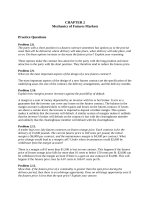Solutions fundamentals of futures and options markets 7e by hull chapter 08
Bạn đang xem bản rút gọn của tài liệu. Xem và tải ngay bản đầy đủ của tài liệu tại đây (46.55 KB, 3 trang )
Chapter 8
Securitization and the Credit Crisis of 2007
Practice Questions
Problem 8.8.
Why did mortgage lenders frequently not check on information provided by potential
borrowers on mortgage application forms during the 2000 to 2007 period?
Subprime mortgages were frequently securitized. The only information that was retained
during the securitization process was the applicant’s FICO score and the loan-to-value ratio
of the mortgage.
Problem 8.9.
How were the risks in ABS CDOs misjudged by the market?
Investors underestimated how high the default correlations between mortgages would be in
stressed market conditions. Investors also did not always realize that the tranches underlying
ABS CDOs were usually quite thin so that they were either totally wiped out or untouched.
There was an unfortunate tendency to assume that a tranche with a particular rating could be
considered to be the same as a bond with that rating. This assumption is not valid for the
reasons just mentioned.
Problem 8.10.
What is meant by the term “agency costs”? How did agency costs play a role in the credit
crisis?
“Agency costs” is a term used to describe the costs in a situation where the interests of two
parties are not perfectly aligned. There were potential agency costs between a) the originators
of mortgages and investors and b) employees of banks who earned bonuses and the banks
themselves.
Problem 8.11.
How is an ABS CDO created? What was the motivation to create ABS CDOs?
Typically an ABS CDO is created from the BBB-rated tranches of an ABS. This is because it
is difficult to find investors in a direct way for the BBB-rated tranches of an ABS.
Problem 8.12.
Explain the impact of an increase in default correlation on the risks of the senior tranche of
an ABS. What is its impact on the risks of the equity tranche?
As default correlation increases, the senior tranche of a CDO becomes more risky because it
is more likely to suffer losses. As default correlation increases, the equity tranche becomes
less risky. To understand why this is so, note that in the limit when there is perfect correlation
there is a high probability that there will be no defaults and the equity tranche will suffer no
losses.
Problem 8.13.
Explain why the AAA-rated tranche of an ABS CDO is more risky than the AAA-rated
tranche of an ABS.
A moderately high default rate will wipe out the tranches underlying the ABS CDO so that
the AAA-rated tranche of the ABS CDO is also wiped out. A moderately high default rate
will at worst wipe out only part of the AAA-rated tranche of an ABS.
Problem 8.14.
Explain why the end-of-year bonus is sometimes referred to as “short-term compensation.”
The end-of-year bonus usually reflects performance during the year. This type of
compensation tends to lead traders and other employees of banks to focus on their next bonus
and therefore have a short-term time horizon for their decision making.
Further Questions
Problem 8.15
Suppose that the principal assigned to the senior, mezzanine, and equity tranches is 70%,
20%, and 10% for both the ABS and the ABS CDO in Figure 8.3. What difference does this
make to Table 8.1?
Losses to
subprime
portfolio
10%
13%
17%
20%
Losses to Mezz
tranche of ABS
0%
15%
35%
50%
Losses to equity
tranche of ABS
CDO
0%
100%
100%
100%
Losses to Mezz
tranche of ABS
CDO
0%
25%
100%
100%
Losses to senior
tranche of ABS
CDO
0%
0%
7.1%
28.6%
Problem 8.16
Investigate what happens as the width of the mezzanine tranche of the ABS in Figure 8.3 is
decreased with the reduction of mezzanine tranche principal being divided equally between
the equity and senior tranches. In particular, what is the effect on Table 8.1?
The ABS CDO tranches become similar to each other. Consider the situation where the
tranche widths are 12%, 1%, and 87% for the equity, mezzanine, and senior tranches. The
table becomes:
Losses to
subprime
portfolio
10%
13%
17%
20%
Losses to Mezz
tranche of ABS
0%
100%
100%
100%
Losses to equity
tranche of ABS
CDO
0%
100%
100%
100%
Losses to Mezz
tranche of ABS
CDO
0%
100%
100%
100%
Losses to senior
tranche of ABS
CDO
0%
100%
100%
100%
Problem 8.17
Why was there a transparency problem in the subprime mortgage market? Why is a lack of
transparency in financial markets considered to be bad? What steps can be taken to improve
transparency?
It was very difficult to understand and model how tranches depended on each other. As soon
as there was considered to be a problem with the underlying assets (mortgages), market
participants were unable to value tranches and the market for the tranches virtually
disappeared. Better documentation, possibly using software rather than words to explain the
way cash flows are calculated, would help. The transparency problem is largely created by
resecuritization (i.e. the creation of tranches from tranches). This practice is likely to be
unacceptable to the market in the future (at least for a few years).









